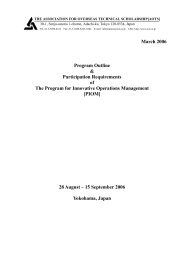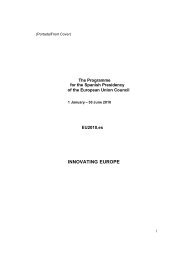Analysis of the Operation and Financial Condition of the Enterprise
Analysis of the Operation and Financial Condition of the Enterprise
Analysis of the Operation and Financial Condition of the Enterprise
You also want an ePaper? Increase the reach of your titles
YUMPU automatically turns print PDFs into web optimized ePapers that Google loves.
<strong>Analysis</strong> <strong>of</strong> <strong>the</strong> <strong>Operation</strong> <strong>and</strong> <strong>Financial</strong> <strong>Condition</strong> <strong>of</strong> <strong>the</strong> <strong>Enterprise</strong>At <strong>the</strong> normal level this ratio should not exceed 40%. Creditors usually want tosee lower debt ratios, because it is more certain that <strong>the</strong>y would without any obstructionsreceive <strong>the</strong> amounts lent. Higher debt ratio means that high interest rate is paid on <strong>the</strong>loans, <strong>and</strong> <strong>the</strong> terms <strong>of</strong> crediting will be strict or an enterprise may even lose <strong>the</strong> chance toreceive a loan.Risk plays <strong>the</strong> main role in assessment <strong>of</strong> <strong>the</strong> level <strong>of</strong> liabilities. Most <strong>of</strong>ten <strong>the</strong>reare two types <strong>of</strong> risk that <strong>the</strong> enterprises may face: business risk associated with normal level <strong>of</strong> activities in <strong>the</strong> operating conditions; financial risk arising from <strong>the</strong> method by which <strong>the</strong> enterprise assets are financed.The underlying principle is as follows: if <strong>the</strong> business risk is high, nei<strong>the</strong>r <strong>the</strong>financial risk should be undertaken.The size <strong>of</strong> <strong>the</strong> level <strong>of</strong> liabilities depends also on <strong>the</strong> state legislation regardingissuing <strong>of</strong> loans, <strong>the</strong> interest rate as well as <strong>the</strong> peculiarities <strong>of</strong> an enterprise, <strong>the</strong> area <strong>of</strong>business etc. conditions.The financial independence <strong>of</strong> an enterprise is also described by a measure called<strong>the</strong> independence ratio which is also called <strong>the</strong> financial leverage (gearing) which iscalculated by dividing <strong>the</strong> liabilities <strong>of</strong> an enterprise by its equity:<strong>Financial</strong>leverage =(gearing)LiabilitiesEquity capital(4.9.)Ratio shows, what <strong>the</strong> amount <strong>of</strong> borrowed capital payable per one lat <strong>of</strong> equity capitalis. Dynamic increase in this ratio may evidence <strong>the</strong> ability <strong>of</strong> <strong>the</strong> enterprise to exp<strong>and</strong> itsoperations on <strong>the</strong> account <strong>of</strong> raising <strong>the</strong> debt capital. At <strong>the</strong> same time it may be anindicator <strong>of</strong> a growing financial dependence on borrowed capital.Experts believe that if <strong>the</strong> level <strong>of</strong> this ratio has reached 1, <strong>the</strong> financial stability<strong>of</strong> an enterprise is under <strong>the</strong> threat, however, <strong>the</strong>re is no one single solution regarding <strong>the</strong>critical limit <strong>of</strong> this ratio. This ratio depends on <strong>the</strong> type <strong>of</strong> business activities <strong>and</strong> <strong>the</strong> rate<strong>of</strong> turnover <strong>of</strong> current assets. If <strong>the</strong> turnover <strong>of</strong> current assets is high, <strong>the</strong> critical limit <strong>of</strong>this ratio may considerably exceed 1 without seriously affecting <strong>the</strong> financial autonomy <strong>of</strong>an enterprise.Creditors usually select <strong>the</strong> lower level <strong>of</strong> this measure. High level <strong>of</strong> dependencefrom external debt may considerably impair <strong>the</strong> conditions <strong>of</strong> an enterprise incircumstances when <strong>the</strong> rate <strong>of</strong> sales <strong>of</strong> goods is decreasing, because <strong>the</strong> expenses forpayment <strong>of</strong> interest on loans are believed to be relatively fixed, i.e., <strong>the</strong> expenses which ino<strong>the</strong>r similar conditions would not decrease proportionally with <strong>the</strong> reduction in <strong>the</strong> salesvolume <strong>of</strong> goods.Evaluation <strong>of</strong> this measure depends on <strong>the</strong> following positions: <strong>the</strong> level <strong>of</strong> <strong>the</strong> ratio in o<strong>the</strong>r industries; what <strong>the</strong> possibilities are for an enterprise to receive fur<strong>the</strong>r loans; stability <strong>of</strong> business performance.74
















